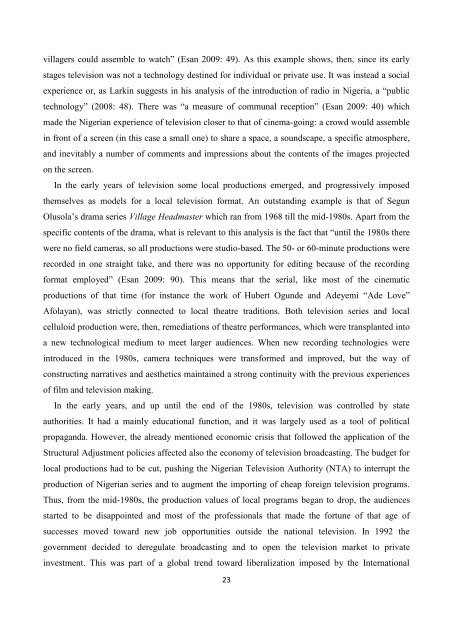Create successful ePaper yourself
Turn your PDF publications into a flip-book with our unique Google optimized e-Paper software.
villagers could assemble to watch” (Esan 2009: 49). As this example shows, then, since its earlystages television was not a technology destined for individual or private use. It was instead a socialexperience or, as Larkin suggests in his analysis of the introduction of radio in Nigeria, a “publictechnology” (2008: 48). There was “a measure of communal reception” (Esan 2009: 40) whichmade the Nigerian experience of television closer to that of cinema-going: a crowd would assemblein front of a screen (in this case a small one) to share a space, a soundscape, a specific atmosphere,and inevitably a number of comments and impressions about the contents of the images projectedon the screen.In the early years of television some local productions emerged, and progressively imposedthemselves as models for a local television format. An outstanding example is that of SegunOlusola’s drama series Village Headmaster which ran from 1968 till the mid-1980s. Apart from thespecific contents of the drama, what is relevant to this analysis is the fact that “until the 1980s therewere no field cameras, so all productions were studio-based. The 50- or 60-minute productions wererecorded in one straight take, and there was no opportunity for editing because of the recordingformat employed” (Esan 2009: 90). This means that the serial, like most of the cinematicproductions of that time (for instance the work of Hubert Ogunde and Adeyemi “Ade Love”Afolayan), was strictly connected to local theatre traditions. Both television series and localcelluloid production were, then, remediations of theatre performances, which were transplanted intoa new technological medium to meet larger audiences. When new recording technologies wereintroduced in the 1980s, camera techniques were transformed and improved, but the way ofconstructing narratives and aesthetics maintained a strong continuity with the previous experiencesof film and television making.In the early years, and up until the end of the 1980s, television was controlled by stateauthorities. It had a mainly educational function, and it was largely used as a tool of politicalpropaganda. However, the already mentioned economic crisis that followed the application of theStructural Adjustment policies affected also the economy of television broadcasting. The budget forlocal productions had to be cut, pushing the Nigerian Television Authority (NTA) to interrupt theproduction of Nigerian series and to augment the importing of cheap foreign television programs.Thus, from the mid-1980s, the production values of local programs began to drop, the audiencesstarted to be disappointed and most of the professionals that made the fortune of that age ofsuccesses moved toward new job opportunities outside the national television. In 1992 thegovernment decided to deregulate broadcasting and to open the television market to privateinvestment. This was part of a global trend toward liberalization imposed by the International23
















